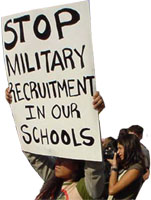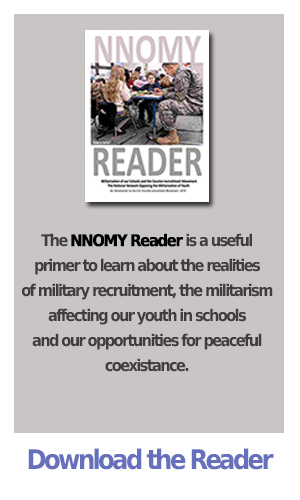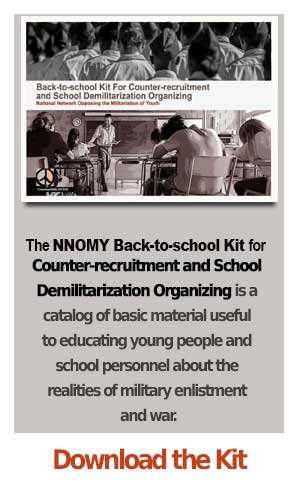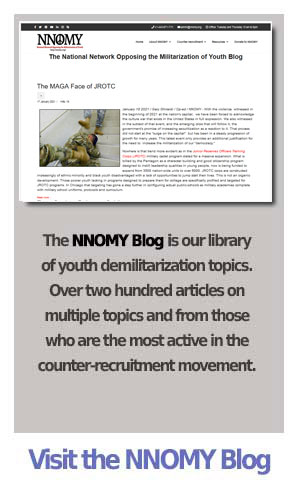COUNTER RECRUITER ACCESS TO HIGH SCHOOLS
 Equal access refers to the lawful activity of countering military recruitment inside high schools. It is not the only way to reach and educate young people who are targeted for military recruitment, but it is an effective way to counter military recruitment where it is having a major impact.
Equal access refers to the lawful activity of countering military recruitment inside high schools. It is not the only way to reach and educate young people who are targeted for military recruitment, but it is an effective way to counter military recruitment where it is having a major impact.
Equal access for non-students is explained in the 1986 ruling in San Diego Committee v. Governing Board of Grossmont Union High School District [790 F.2d 1471 (9th Cir.1986)]. In simple terms, equal access rests on the principle that once a government agency creates a forum for expressive activity on a controversial topic, access to the forum can be limited only so long as it is reasonable and not a façade for viewpoint-based discrimination. If the presentation of one point of view has been allowed, the forum must also be opened to those with an opposing view on the same topic.
Key document: see “Using Equal Access to Counter Militarism in High Schools.”
The above document explains the following:
In the effort to counter the military in secondary schools, three main organizing models have developed:
· Educational activities organized in schools by students themselves (e.g. clubs and campaigns). Students have the right to speak out on issues in their schools whether or not the other side has already been presented. For more on students’ rights, including some legal limitations, see Guide to High School Students' Rights.
· Educational outreach conducted by students and/or non-students outside of official school channels (e.g. by leafleting on public property at school entrances). This does not require an equal access argument, though expressive activities on public property can be controlled by reasonable regulation.
· Attempts by non-students to get information to young people through the school system itself. This approach can sometimes require educating school personnel about the principle of equal access and forums on government property.
What triggers the right to equal access?
To establish equal access, an existing forum on the topic of military enlistment must be identified. Examples would be if military representatives were allowed to:
- Speak in classrooms or at assemblies,
- Place recruitment materials in career centers, counseling offices, libraries or on bulletin boards,
- Place ads in student newspapers,
- Staff information tables at career/college fairs or in lunch areas,
- Approach students in lunch areas, hallways, etc.,
- Visit the school with special mobile recruiting vehicles,
- Give the ASVAB test.
When these and other forums have been granted to military representatives, those with an opposing view have a legal right to the same access to students.
What speech content is allowed with equal school access?
· Speech content that fits within the specific topic of the forum that has been established is legally allowed; for example, explaining the possible negative consequences of military enlistment and realities of the job, including war.
· Distributing a general anti-war message or information that is not directly related to what recruiters are saying would technically be outside the forum and could possibly be excluded.
Should I use legal threats to gain access?
This is a very complicated question that cannot be answered easily here, except to say that the courts are generally willing to overlook our constitutional rights when it comes to defending the ability of the military to recruit. Those who have been doing this work for a long time—including some who have used litigation—have learned that it’s more effective to reach out to students in ways that avoid threats of litigation; for example, by going initially to teachers and counselors, or seeking to reach students outside of school, rather than going straight to administrators or governing boards. Read more about the reasons for this in “Using Equal Access…,” and contact Project YANO for advice from those who have been involved in litigation and also learned to gain access without it.
Resources
- The National Network Opposing the Militarization of Youth 2015 Back-to-school Kit for Counter-recruitment and School Demilitarization Organizing is available to assist you in understanding the work, your rights, and the challenges to return to the public schools to counter-recruit. Please visit this page and review the materials we have assembled for you and feel free to ask questions as well at Our Contact Page and we will do our best to answer you or your group in a timely manner.
- Using Equal Access to Counter Militarism in High Schools
- School District Policies Documents (archived)
- Ninth Circuit Court Ruling: Equal Access to High Schools (PDF) (archived)
- 'Counter-recruiters' shadowing the military
- Guide to High School Leafleting and Petitioning
Revised 11/11/2019


 The military has maximized its presence and influence in the educational system by seeking the widest possible access to classrooms, school career centers, counseling offices, student records, student newspapers and even elementary school playgrounds.
The military has maximized its presence and influence in the educational system by seeking the widest possible access to classrooms, school career centers, counseling offices, student records, student newspapers and even elementary school playgrounds.




